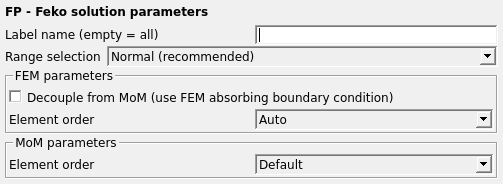FP Card
Options related to the Feko solution parameters is set using the FP card. The basis functions used when using FEM or MoM is set globally or on specific labels.
On the Solve/Run tab, in the Solution
settings group, click the ![]() Basis function (FP) icon.
Basis function (FP) icon.

Figure 1. The FP - Feko solution parameters dialog.
Parameters:
- Label name (empty = all)
- Label of elements on which the basis function settings will be applicable. When this field is empty, the setting will be applied globally on all elements.
- Range selection
- Specify the preferred range that should be used for the higher order basis function selection when the order is set to Auto. This setting is used by the Feko kernel to influence the order that will be used for a particular triangle size. Selecting higher orders will result in computation time and memory usage to increase if the mesh remains unchanged. Lower orders will reduce computation time and memory usage.
FEM parameters
The FEM parameters are applied globally and cannot be applied only to a subset of the mesh elements. The value of the label field will be ignored for FEM settings.
- Decouple from MoM (use FEM absorbing boundary condition)
- The MoM/FEM hybrid method fully couples the FEM and MoM techniques and also the surface of the FEM region is treated by the method of moments. For certain applications when there is a larger separation between the MoM and the FEM regions (for example, human body with a GSM base station antenna) this decoupling check box can be checked. When the FEM and MoM are decoupled, similar to switching off the coupling for the MoM/PO or MoM/UTD hybrid methods, first the MoM region is solved for while neglecting the FEM domain, and the MoM solution is used as an impressed excitation for the FEM solution. The MoM is also not used on the FEM surface when they are decoupled, but rather an absorbing boundary condition is applied on the FEM surface. The advantage of this decoupling is a saving of memory and computation time.
- Element order
-
Three options are available for the order of the FEM solution. The Auto option allows the Solver to select the order automatically. Second order will be used by default. However, when having a fine mesh (like modelling details of a biological structure), then one might consider switching to first order only to reduce the number of unknowns.
When first order is selected, then CT/LN basis functions are used everywhere, on the boundary and inside the FEM region. When switching to first order, normally a finer mesh is required to get the same solution accuracy compared to second order basis functions.
When second order is selected, Feko uses hierarchical tetrahedral elements with LT/QN (linear tangential/quadratic normal) vector basis functions for the electric field inside the FEM region. On the boundary surface of the FEM region CT/LN (constant tangential/linear normal) vector basis functions are used for the equivalent electric and magnetic surface currents.
MoM parameters
- Element order
-
The order of the basis functions used for the MoM is determined by this setting.
The Default option selects the default order used in Feko. The default is currently set to use RWG (Rao-Wilton-Glisson) [Rao-Wilton-Glisson] basis functions.
The Auto option allows Feko to determine the best order to use. The order of the basis function is determined by the size of the triangle and influenced by the Range selection setting.
Hierarchical basis functions can be used by selecting any of the orders in the list (0.5, 1.5, 2.5 or 3.5). Higher order basis functions have more unknowns,but they allow the triangle size to be increased considerably